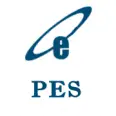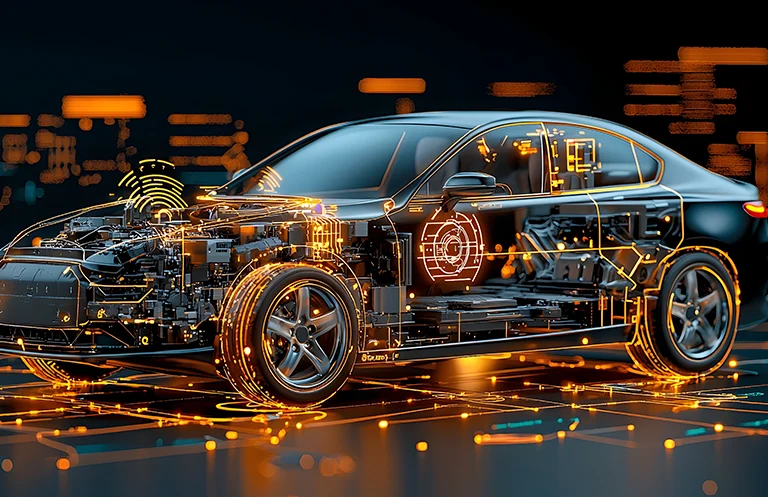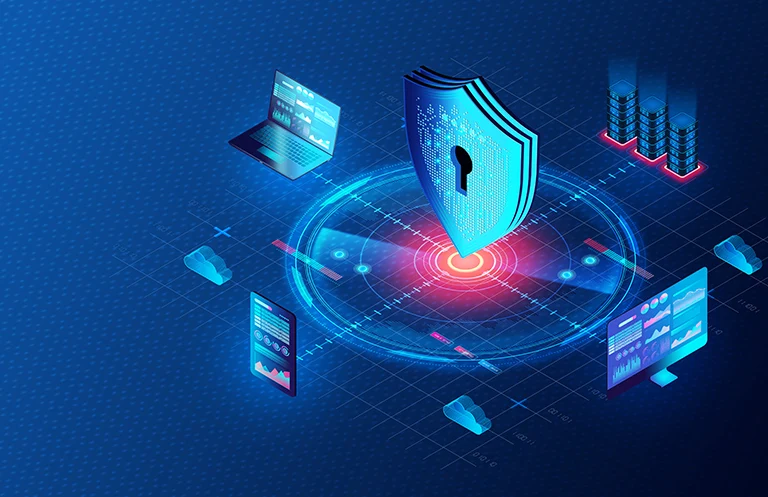01. What is Automotive IoT?
The term ‘automotive IoT’ refers to embedding IoT technologies into automotive systems to create new applications and solutions which enable vehicles to provide a smarter, safer, efficient, and more comfortable driving experiences. It also refers to a complex system of devices (e.g., GPS Trackers, Sensors, Cameras) that are connected to the cloud and provide real-time data that enables optimization of the car manufacturing process and better transport management.
02. What are the key applications of IoT in automotive systems?
IoT technologies are used in the automotive sector to create innovative and advanced solutions, including connected car solutions, Advanced Driver-Assistance Systems (ADAS), in-vehicle infotainment systems, navigation & telematics solutions, predictive maintenance solutions, Vehicle-to-Vehicle (V2V) applications, Vehicle to Infrastructure (V2I) applications, and Vehicle to Everything (V2X) communication applications.
03. What is ADAS (Advanced Driver-Assistance Systems)?
ADAS (Advanced Driver-Assistance Systems) is an umbrella term used for various types of active safety systems in vehicles which allow drivers to take timely control of the vehicle by alerting them of potential hazards on the road. ADAS systems scan the surroundings of the vehicle using vision, RADAR and LIDAR-based in-vehicle systems and provide assistance to the driver for a safer and more comfortable driving experience. Some key ADAS features include Adaptive Cruise Control (ACC), Lane Departure Warning Systems, Collision Warning Systems, Blind Spot Detection Systems, Night Vision Systems, and Parking Assistance Systems.
04. What common types of ADAS systems are used in the automotive industry?
ADAS systems can be classified into three main categories based on the technologies they use:
- Vision-based ADAS systems: Vision-based ADAS systems are comprised of onboard automotive cameras, which are installed in front, rear and both the sides of the vehicle. They are eyes of any vehicle and assists by sending collision warning alerts, providing vehicle parking assistance, performing object recognition, and offering lane change assistance and more. Vision-based ADAS systems are comprised of embedded vision systems which use image signal processing algorithms to identify and detect objects in their field of view.Know more about vision-based ADAS systems, read this article: Experience Safe and Smart Driving with Vision-based Advanced Driver-Assistance Systems (ADAS)
- RADAR-based ADAS systems: RADAR-based ADAS systems are several steps ahead of Vision-based ADAS systems. Automotive cameras are insufficient in providing ADAS data in poor weather and low-visibility conditions, while RADAR-based systems work quite well even in inclement weather. RADAR-based systems have a longer range and they can also pass through objects and can detect the position and velocity of approaching vehicles and other objects on the road.Learn more: Why Automotive Companies Should Adopt RADAR-based ADAS Systems
RELATED BLOG
- LIDAR-based ADAS Systems: LIDAR stands for Light Detection Imaging and Ranging. LIDAR-based ADAS systems go way beyond vision and Radar-based ADAS systems as they can not only see through the objects, but also differentiate between on-road objects like vehicles, pedestrians, people, bikes, etc. LIDAR systems are capable of creating a 3D map of the vehicle surroundings for a good distance, providing highly accurate object detection and recognition for safer and more efficient driving.
05. How is IoT transforming in-vehicle infotainment systems?
IoT is the main driver of modern in-vehicle infotainment systems. IoT enables infotainment systems to be connected with other in-vehicle systems, and also with external devices for internet connectivity. IoT-enabled infotainment systems are capable of providing information on navigation and telematics. They also provide a range of entertainment options and support connectivity with smartphones. Android-based infotainment systems, supported and encouraged by Google, are ready to transform the market. Such infotainment systems will support a range of apps, including Google Maps, Google Assistant and several apps from the Play Store.
06. How do IoT systems help with predictive maintenance in vehicles?
IoT gateway platforms for automotive provide connectivity to in-vehicle sensors, helping to generate and deliver preventive and predictive maintenance alerts to the driver. In-vehicle sensors keep track of the vehicle’s functional metrics such as acceleration, tire pressure, engine temperature, fuel level, engine-oil, brake fluid level, emissions, and more, and notify the driver of any of the probable issues in advance.
07. What are automotive telematics systems?
Telematics is a technology supported by telecommunication and IT systems, used to monitor and track a vehicle’s location, movements and other vehicle diagnostics details. Automotive telematics systems can track real time details of the vehicle like speed and idling, fuel usage, tire pressure, vehicle breakdown etc.
08. How are telematics systems leveraging IoT for improved functionality?
Telematics systems supported by IoT technologies are transforming fleet management and vehicle transportation industry by enabling more accurate and in-depth tracking of vehicles. IoT technologies integrated with telematics systems enhance business processes by managing interconnectivity between in-vehicle devices, cloud architecture, and the systems located in fleet management companies to record, and interact with vehicles in-transit, in real time. IoT solutions empower telematics systems to easily customize its services as per industry requirement and the nature of the business.
09. What types of telematics solutions are available in the market?
Three types of telematics solutions are available in the market:
- Plug-and-play OBD port II Telematics Devices: Plug-and-play telematics devices are plugged into the OBD II (On board diagnostics) port of the vehicle and they allow the user to get vehicular data like vehicle speed, RPM, fuel system status, emissions, engine performance, mileage, etc.
- Telematics Applications: Mobile-based telematics applications are a convenient option for vehicle tracking. In-vehicle sensors are connected with the smartphone via Bluetooth, and the telematics data can be shared easily through mobile apps.
- Hardwired telematics Devices: Hard-wired telematics devices are robust vehicle tracking devices which are mechanically fitted into the vehicle. Hardwired telematics devices use the Telematics Control Unit (TCU) which retrieves data from Engine Control Unit of the vehicle and shares telematics data to the controller.
RELATED BLOG
10. What are the key benefits of telematics in fleet management?
Telematics systems are very useful in tracking fleet operations. Some of the advantages of telematics systems in fleet management are as follows:
- Route optimization
- Reducing fuel usage
- Reduce operational expenses
- Improve driver safety
- Increase fleet security
- Remotely diagnose maintenance requirements
11. What is the difference between telematics and infotainment solutions?
In-vehicle infotainment systems provide information and entertainment in a vehicle, which includes music streaming, phone to infotainment system connectivity, navigation, video player, in-car internet, hands free calling, etc.
On the other hand, telematics strictly adheres to informatics and does not support entertainment features in the vehicle. Telematics systems and their applications are mostly designed to serve a commercial objective through the vehicle, like fleet tracking solutions, navigations, telematics for insurance, two-way communication to send on-board vehicular data, vehicle diagnostics and maintenance notifications, sending alerts in case of vehicle collision, etc.
12. What are the main components of in-vehicle infotainment system?
Latest In- vehicle infotainment system comprises of Integrated Heads-up unit to display vehicle’s real time information like navigation, speed, multimedia etc. It also has Head Unit – a centralized control center for the system, Operating systems like Android, Linux, WNX, Windows, to support connectivity and functions, powerful DSPs, and GPUs to assist information display in multiple screens simultaneously, CANBUS, digital instrument cluster to display speedometer, RPM, odometer digitally.
13. What are the key features of In-vehicle infotainment systems?
Some of the high-end features of modern in-vehicle infotainment systems are high-resolution touch screen (up to 20 inches wide), smartphone pairing using Bluetooth connectivity, and digital tuners for radio, multimedia support through Aux cable, Bluetooth, USB, and HDMI cable. Android auto and apple car play with advanced vehicular functions like parking assistance, voice assistants are also key features of infotainment systems.
14. What are over-the-air (OTA) updates in automotive?
Over-the air software updates is one of the trending automotive connectivity solutions. It keeps vehicle up-to-date with regular updates to its firmware and software and remotely fix faulty software. OTA updates supported by IoT cloud connectivity are helpful in updating latest files to assist applications like infotainment, telematics, ADAS systems, ECUs, and more.
15. What are automotive surround-view camera systems?
Automotive surround view system provides better visibility and orientation (360-degrees) around the vehicle, and helps in mitigating collisions, and other vehicle damages during lane change, parking, and maneuvering. It consists of four fish eyed cameras installed in rear, front and both sides of the vehicle and provides 2D (bird’s eye view) and 3D representation of vehicles surroundings.
16. What is automotive HMI solutions?
Human Machine Interface in automotive can be considered as information exchange and communication channel between driver/ passengers and the vehicle which connects them with the outside world. Automotive HMI solutions is a key to emerging autonomous vehicle trends, which ensures integration of infotainment systems with ADAS, V2V, V2I and V2X connectivity solutions.
17. What Automotive Engineering Services and Solutions does eInfochips offer?
eInfochips, as an automotive engineering solutions provider, assists automotive companies in vehicular electronics, embedded systems development, software development, and cloud connectivity for connected cars. Some of the automotive solutions offered by eInfochips include:
- Advanced Driver-Assistance Systems (ADAS)
- Embedded Software
- Connectivity Solutions
- Infotainment Systems
- Smart Transit Systems












